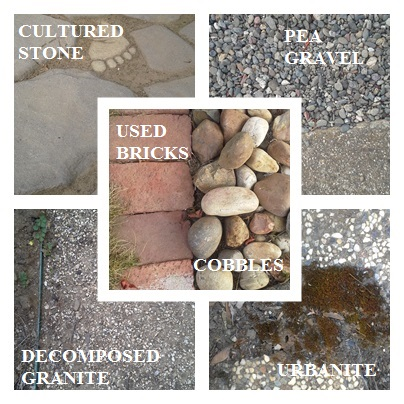
California's ongoing water situation has produced many suggestions for dealing with drought conditions. One pertinent idea is permeable hardscapes. Permeable means that a material allows liquids or gases to pass through it.Hardscapes are the non-living or man-made sections of an outdoor area such as driveways, walkways and patios.
Traditionally a lot of the hardscapes in our yards have been made of non-permeable materials, such as concrete. Non-porous materials in a city or town environment encourage the runoff of possibly polluted waters and the overflow of the storm sewers which at times may cause flooding. Additionally because the water is unable to penetrate the surface the soil dries out and moisture is unavailable to hydrate nearby plantings,increasing the need for irrigation in the dry season.
Permeable materials allow the water to slowly percolate through. The filtering of the water by the permeable material,as well as chemical interactions with soil and soil organisms, removes a large portion of the pollutants and allows the water to return to the aquifers much refreshed. The soil is also able to store the water for the use of nearby plants so you do not have to supplement their water needs as much.
If we had cemented the area I probably would not have gone to the labor and expense of removing it. At one point we did take out a section of concrete from another area in our yard, and it was a lot of heavy work. Rather than send the concrete to the land fill, I was able to recycle it into a retaining wall. Reused concrete chunks are sometimes called “urbanite”.
I decided to check out permeable hardscapes to see what the costs were and just what materials were available out there. The selection of cement pavers, decomposed granite, gravel, mulch and so on is legion. You can also use a product called pervious concrete, which looks and acts like concrete in the landscape but allows water to pass through.
The pavers, permeable concrete, and similar products need a good base and mostly professional installation. The flagstone I liked but car traffic would probably crack the slabs. I thought of decomposed granite (DG) but the installation I found was labor intensive. I love the cobbles I have in other areas of my yard but their uneven surfaces would not work at this location.
The side yard had been filled with pea gravel for a dog run at one time. Over the years the gravel had been joined by silt and soil to create a hard packed material and it had become a haven for difficult to remove weeds. I decided just to refresh with that same material. Pea gravel is permeable. When the gravel is loose, it is easy to remove the occasional weed with a stirrup type hoe, and if you have pets the removal of pet feces is simple.
I dug the area down about 4 inches and removed the gravel/soil to another location. It made a fine walking surface around my raised beds.We then computed the amount of pea gravel needed and had it delivered. Because the location was right on the street the delivery truck was able to dump it right where it needed to be. This was super convenient as now all I had to do was spread it around with no wheel barrow involvement at all. After a few hours of hard, sweaty labor the area looked refreshed and new.
Both the cost and labor commitment fulfilled all my expectations. It looks great and more importantly it is permeable. The only downside is that the pea gravel tends to spread and needs frequent sweeping to return it to the designated area. Overall, though, I am happy with the entire project.
If you are choosing hardscapes for your yard, it is worth the time to check out permeable material options. You can beautify your landscape and conserve some of our precious water at the same time.
Garden Tour: The UC Master Gardeners of Napa County invite you to attend their sixth garden tour, “Down the Garden Path,” on Sunday, September 13. On this self-guided educational tour, you will see seven gardens by Master Gardeners in and around the City of Napa. These gardens illustrate how Napa County Master Gardeners use University of California research-based horticultural information to develop and maintain their own gardens. Tickets: $30 advance / $35 day of event. Purchase tickets here: http://ucanr.edu/ucmgnapa Or you can purchase tickets at the Master Gardener office (address below). For more information, call 707-253-4143.
Master Gardeners are volunteers who help the University of California reach the gardening public with home gardening information. UC Master Gardeners of Napa County ( http://ucanr.org/ucmgnapa/) are available to answer gardening questions in person or by phone, Monday, Wednesday and Friday, 9 a.m. to Noon, at the U. C. Cooperative Extension office, 1710 Soscol Avenue, Suite 4, Napa, 707-253-4143, or from outside City of Napa toll-free at 877-279-3065. Or e-mail your garden questions by following the guidelines on our web site. Click on Napa, then on Have Garden Questions? Find us on Facebook under UC Master Gardeners of Napa County.